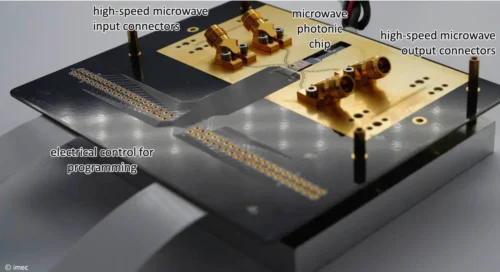The chip combines optical and microwave components to handle signal processing on a single platform, reducing size, power consumption, and system complexity.

Researchers from imec and Ghent University’s Photonics Research Group and IDLab have built an integrated microwave photonics system on a silicon chip. The chip combines optical and microwave signal processing, bringing together modulators, filters, photodetectors, and transfer-printed lasers. It is self-contained and programmable for high-frequency signal processing tasks.
The chip is made using imec’s iSiPP50G silicon photonics platform. It includes waveguides, modulators, detectors, and phase shifters for tuning. An indium phosphide optical amplifier, transfer-printed onto the chip, works as a tunable laser source. This amplifier, developed by III-V Lab and integrated using a technique from imec/Ghent University, enables full on-chip light generation and control.
Modern networks must process both optical and microwave signals as data volumes increase and systems transition to higher frequencies. Traditional systems rely on separate components—fibre-based photonics and microwave hardware that are hard to scale and use more power.
This chip-based approach avoids those limits. Its modulator and filter reduce signal loss and improve modulation control. This enables signal processing to be performed entirely on-chip, thereby improving energy efficiency and reducing chip size.
The system replaces large setups with a single scalable chip. It enables smaller, lower-cost, and more energy-efficient systems for high-frequency uses such as 5G/6G infrastructure, satellite links, radar, and sensing. By combining key optical and microwave components into a single
chip, the technology enables communication systems that are easier to deploy and scale.
“The ability to integrate all essential microwave photonics components on a single chip marks a major step toward scalable and energy-efficient high-frequency signal processing,” said Wim Bogaerts, professor in the Photonics Research Group at Ghent University and imec. “By eliminating bulky external components, this technology paves the way for more compact, cost-effective solutions in next-generation wireless networks and advanced sensing systems.”








